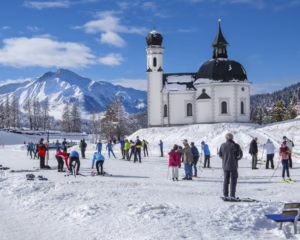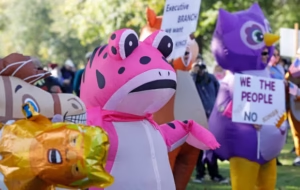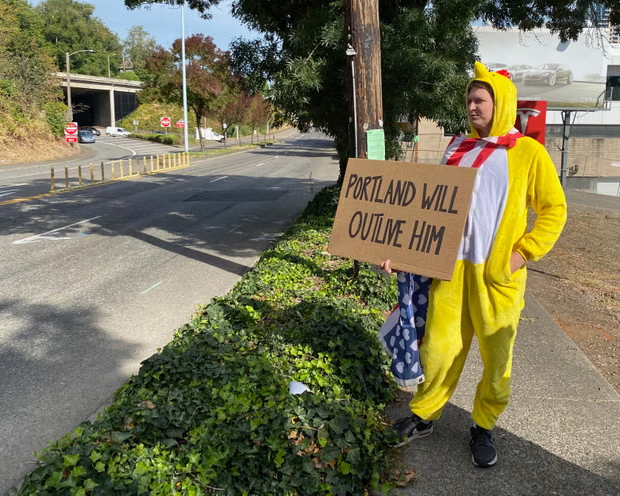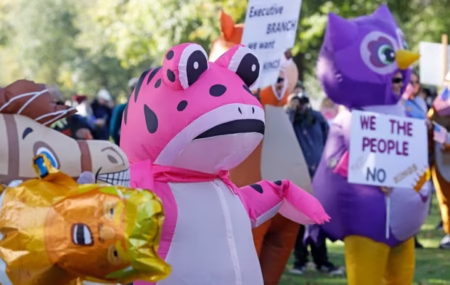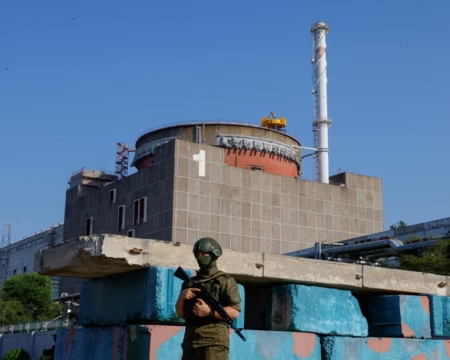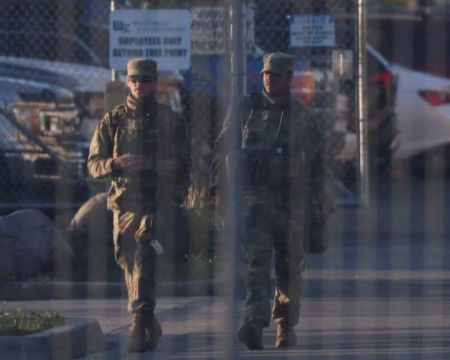Donald Trump’s order to send the national guard to Portland, Oregon, has drawn widespread criticism and local ridicule. The former president described the city as “war ravaged” and claimed immigration offices were “under siege” by antifascists and other groups. Yet a visit to Portland over the weekend showed a very different picture, with calm streets and only a handful of protesters.
Outside the Immigration and Customs Enforcement office, just four demonstrators were present. Jack Dickinson, dressed in a chicken costume draped with an American flag, held a sign reading “Portland Will Outlive Him.” Dickinson, a local resident and organizer of the ongoing three-month protest, said Trump’s threat to use “full force” against the small group was unnecessary. He argued that the president’s view of Portland had been shaped by selective videos and misleading reports.
Another protester, who goes by the nickname Burrito, said he was protesting what he described as wrongful detentions by federal agents. He rejected Trump’s depiction of the city as a war zone, calling it “disgusting” and inaccurate. Activists noted that any clashes had resulted from federal agents’ actions, not the protesters themselves.
The ICE office also draws attention because of its location next to a Tesla dealership. Demonstrators held signs criticizing the company’s ties to federal agencies, including one that read “Tesla Funds Fascism/Stop Buying Teslas.” Protesters said the demonstrations were small but persistent, designed to maintain pressure on federal authorities rather than provoke violence.
Despite Trump’s statements, downtown Portland appeared peaceful. Coffee shops, restaurants, and the farmers’ market were full of residents and tourists enjoying their weekend. Families shopped for fresh produce and ate at local vendors, including businesses started by local entrepreneurs, showing that life continued normally.
The city’s downtown blocks, which had been the center of large protests in 2020 over racial justice and federal interventions, were calm. Outside the federal courthouse, the only person visible was a street sweeper in a neon vest labeled “Clean & Safe.” Fences and plywood that once covered the building and nearby police headquarters during past unrest had long been removed.
Nearby federal buildings, including the Edith Green federal building, showed no unusual activity. This came a day after reports of masked federal agents arriving in armored vehicles, but on Saturday, there was no visible security presence. Meanwhile, the Portland farmers’ market was busy, highlighting a stark contrast between the city’s daily life and the president’s warnings.
Portlanders have taken to social media to mock Trump’s statements, posting images of themselves enjoying the city while audio clips of his claim that living in Portland is “like living in Hell” circulate widely. Residents emphasized that the president’s portrayal was exaggerated and did not reflect reality.
Oregon officials also rejected Trump’s narrative. Governor Tina Kotek said there was no insurrection or threat to national security requiring military intervention. Local leaders warned that sending soldiers into the city could escalate tensions instead of maintaining peace.
The situation highlights ongoing tension between federal authority and local governance. Trump framed Portland as chaotic to justify military deployment, while city leaders maintained that local authorities can manage protests without national guard involvement. Critics argue that federal intervention in such situations sets a dangerous precedent, while supporters say it protects federal property.
Despite the national guard order, the reality on the ground showed a city carrying on with life. The small protest outside the ICE office contrasted sharply with bustling markets, restaurants, and coffee shops. Residents continued shopping, dining, and socializing, showing resilience against political exaggeration.
Portland’s weekend scene demonstrated a community living normally, challenging the president’s description. While the deployment remains a contentious political move, residents continued to show that their city is far from the “war ravaged” image painted by Trump. The contrast between political rhetoric and daily life highlighted the city’s calm and the public’s rejection of exaggerated claims.


